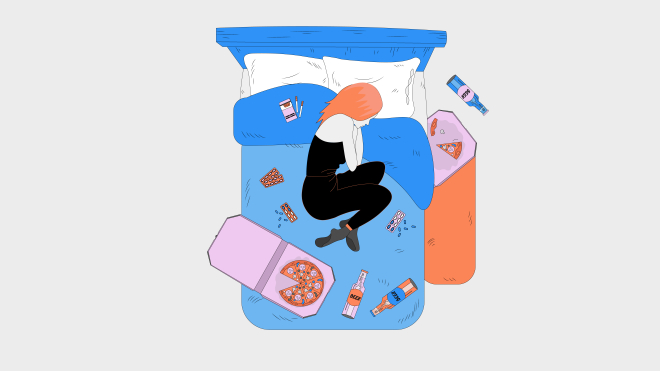What is the essence of CBT?
CBT is based on the so-called cognitive metaphor. Isnʼt it clearer? OK, then letʼs put it more simple. Emotions are usually caused by some events. Often we interpret them incorrectly. These can be real events from life or internal ones — for example, you remembered something and your mood changed. But in fact, it is not the event itself that causes bad emotions, but our interpretation or attitude towards it. These are cognitions, that is, thoughts, convictions and beliefs, through the filter of which we interpret everything that happens to us. So, if cognitions are changed, emotions will also change.
Emotions influence our behavior. If Iʼm anxious, I want to “fight or flight.” If I get angry, I want to punish the enemy. Through behavior, we can influence our emotions. For example, if you donʼt want to practice sports, but you do exercise, itʼs very likely that your mood will improve. When in depression, people often enter so-called social isolation and get locked into themselves. But if you start to communicate a little, even through force, the mood will change.
So, if you adjust your cognitions and behavior, you can change and improve a personʼs emotional state. This is the task of cognitive-behavioral therapy.
Is it possible to change thoughts and beliefs that have been formed for a long time?
Yes, and thatʼs why CBT works. A therapist is a person who helps to look at ready-made, established and possibly harmful interpretations from a different angle. People in therapy can gain certain insights and see things that they previously ignored or considered normal.
CBT is said to be an evidence-based therapy, what does that mean? Will they convince me of something?
No, it is evident in another sense: it is about the evident effect of therapy. CBT has been widely researched — from a scientific point of view, it has shown positive results. But this does not mean that CBT is a perfect and universal mechanism in all cases. It also doesnʼt mean that other psychological practices, such as Gestalt or psychoanalysis, are bad and anti-scientific.
When is CBT prescribed? Is it suitable for everyone?
Aaron Beck originally developed CBT to correct clinical depression. Currently, CBT is a kind of umbrella therapy that combines many directions for the treatment of various disorders or solving life problems. For example, trauma-focused therapy works with PTSD. Scheme therapy is prescribed for the treatment of personality disorders. Compassion-focused therapy focuses on self-compassion. Dialectical-behavioral therapy is used to correct borderline personality disorder, and emotionally-focused therapy is used for relationship problems. We wonʼt cover all of them in detail — this is not a topic for one text.
That is, CBT is a mandatory part of the treatment of various disorders?
No, there are cases when people recover from, for example, a depressive episode with antidepressants, and cases when only CBT is enough. But often the typical recommendation [when correcting or treating disorders] is a combined therapy that includes a course of medication and CBT. For example, during depression, antidepressants “remove” the symptoms: anxiety, sadness, and apathy disappear. But in such a state, persons have distorted ideas about themselves and their symptoms, pills wonʼt directly change this. And CBT can help reduce the risk of relapse.
How do I understand that I need CBT?
If there are any atypically strong emotions, recurring factors, thoughts and ideas, which are noticed not only by you, but also by relatives or friends and which significantly impair the quality of your life. For example, a person constantly says that he or she isnʼt worthy of love and attention. Or is afraid of some disease, suffers from panic disorders or eating disorders. CBT also helps with this.
How to choose a CBT therapist?
First, one must have a full psychological or medical education, additional CBT education, and a permit for clinical practice. Involvement in various regional and international associations is also good in this case. This is not a guarantee of professionalism, but a plus. Itʼs also worth finding out other clientsʼ reviews about the therapistʼs ethics and professionalism. And, of course, your subjective feelings are important. The therapist should approach you as a person. During communication, you should not feel shame, guilt, or other unpleasant emotions. Itʼs about communication, but some exercises in CBT can be unpleasant. For example, if a person is afraid of heights, during therapy it is necessary to gradually (this is key) increase the height to which the client will climb. It is unpleasant, but itʼs important to understand that this is the way to the desired result. This can only be done under the supervision of a therapist.
How long does this therapy last?
CBT belongs to short-term therapies. There are approximate durations in the protocols for different disorders. For example, to deal with a mild depressive episode takes about 15-20 sessions. The more complex the problem, the longer the therapy lasts — in the case of personality disorders, it can be a year or more. But in general, itʼs a reasonable scheduled number of sessions that the therapist discusses with the client.
How much does it cost?
Very different, but definitely not cheap. The price depends on the market conditions and, in fact, the therapist. And in Ukraine, some CBT therapists can even work for free — many are currently working with Ukrainian soldiers.
Translated from Ukrainian by Anton Semyzhenko.
Support Babel so we can make more useful articles:🔸 in hryvnia , 🔸 in cryptocurrency , 🔸 Patreon , 🔸 PayPal: [email protected]
